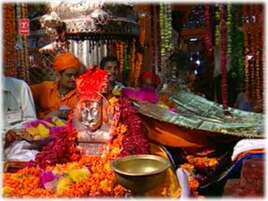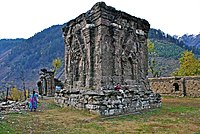Ruler and Hindu folk deity of Rajasthan
| Ramdev | |
|---|---|
| Baba Pir Shah | |
 Ramdev Pir depicted riding a horse with Sufi Saint named Harji Bhati in background Ramdev Pir depicted riding a horse with Sufi Saint named Harji Bhati in background | |
| Ruler of Runicha | |
| Reign | Marwar |
| Predecessor | Ajmal ji Tanwar |
| Born | Chaitra Sudi Panchami V.S. 1405 Undu Kashmir, Barmer, Rajasthan |
| Burial | 1385 Ramdevra, Jaisalmer Rajasthan |
| Spouse | Netal Devi |
| Dynasty | Tanwar |
| Father | Ajmal ji Tanwar |
| Mother | Minal Devi (Menadevi) |
| Religion | Hindu |
Baba Ramdev (or Ramdevji, or Ramdeo Pir, Ramsha Pir (1352–1385 AD; V.S. 1409–1442) is a Hindu deity of Gujarat,Rajasthan and Malwa Madhya Pradesh, India. He was a fourteenth-century Rajput of Pokhran region who was said to have miraculous powers and devoted his life to uplifting the downtrodden and poor people. In Rajasthan, people of Meghwal community are considered to be staunch devotees of Baba Ramdev. Many social groups in India worship him as Ishta-deva. He is considered as an avatar of the god Krishna.
Background
King Ajmal (Ajmal Tanwar) married Queen Minaldevi, daughter of Pamji Bhati of Chhahan Baru village. The sonless king went to Dwaraka and pleaded with Krishna about his wish to have a child like him. They had two sons, the elder Viramdev and the younger Ramdev. Ramdev was born on Chaitra Sudi Panchami in V.S. 1409 in a Rajput family in Ramdevra, Jaisalmer district.
Ramdev believed in the equality of all human beings, be they high or low, rich or poor. He helped the oppressed by granting them their wishes. He is often depicted on horseback. His followers are spread across Rajasthan, Haryana, Punjab, Gujarat and Madhya Pradesh, Mumbai, Delhi and Sindh in Pakistan. Several fairs in Rajasthan are held to commemorate him. Temples in his name are found in many states of India.
Story of King Ajmal

Ajmal arrived at Dwarka and prayed for many days. Ultimately, in sheer disappointment, he asked Krishna's image the reason for deserving such sorrow. The image did not respond to the king's repeated queries. Angered and enraged at this, the king threw a dried laddu at the head of the image. The priest of the temple, considering the king to be mad, asked the king to go to the mystic Dwaraka to speak to the Lord. Dwaraka, swallowed by the sea many centuries prior, lay on the bed of the Arabian Sea. The unfearing king dived into the sea to meet the Lord. Pleased at the king's dedication and faith, the Lord granted him a boon. The king asked for Krishna to be born as his son. Lord promised to come to the king's house. Soon after, the royal couple gave birth to a boy named Bhiramdev. After a few years, Krishna took a small form and appeared next to Bhiramdev. Muslims venerate Ramdev as Ramshah Pir or Rama Shah Peer. He was said to have had miraculous powers, and his fame reached far and wide. Legend has it that five Pirs from Mecca came to test Ramdev's powers. Ramdev welcomed them and requested them to have lunch with him. The Pirs declined, saying that they ate only with their utensils, which were in Mecca. At this, Ramdev smiled and said, "Look, your utensils are coming, " they saw their eating bowls flying in the air from Mecca. After being convinced of his abilities and powers, they paid their homage to him and named him Rama Shah Peer. The five Pirs, who came to test his powers, were so impressed by him that they decided to stay with him. Their graves are located near Ramdev's Samadhi. There are 24 miracles of him which he did in his life.
Poetry and Literature
Ramdev wrote many verbally composed poems, also known as "bāņīs" (utterances), which later on were transcripted and translated by his followers. His most favoured literary work is a collection of his poems by one of his followers named Swami Gokuldas, the "Baba Ramdev Chaubis Praman" (24 pieces of evidence), believed to be pieces of evidence, predictions or simply ways via which one can find the "Satguru", the ultimate pious spiritual guide, who in turn will help one attain the true Supreme God.
In one such couplet, he emphasizes the importance of having known the spiritual guide, saying that whoever will take God's name (Japa), only that person will ever get unaltered comfort and rest, which is the final beatitude, as follows:
"Jo satguru ka levein naamaa, woh hi paavein achal araama" —Page 17, Baba Ramdev Chaubis Praman
A collection of such translated couplets which successfully lead followers to specific conclusions can be found through resources and wayfinding.
Samadhi and Main Temple in Ramdevra
Ramdev took Samadhi at Ramdevra (10 km from Pokhran) in Rajasthan, on Bhadrapada Shukla Ekadashi in V.S. 1442 at the age of 33 years.
The temple complex housing the resting place of Ramdev is located at Ramdevra (10 km from Pokhran) in Rajasthan. The temple structure was built around Ramdev's final resting place by Maharaja Ganga Singh of Bikaner in 1931.
The complex also houses Samadhis of his disciples like Dalibai and some of his chief disciples. The complex also houses the tombs of five Muslim Pirs from Mecca. It also houses a step-well, the water of which devotees believe has healing powers
Ramdev Jayanti
Ramdev Jayanti, the birth anniversary of Ramdev, is annually celebrated in India on Chaitra Sudi Panchami by his dedicated followers.
Baba Ramdevji announced a seven-day fair, spanning from Bhadva Sudi Duj to Bhadva Sudi Ashtami, during which saints of diverse faiths were invited to convene in a spirit of unity. As the designated Ashtami date approached, Baba expressed his intention for Samadhi. Concurrently, Bhaktamati Dali Bai announced her own intention to undertake Samadhi first. Consequently, Baba decided to undergo Samadhi three days later, specifically on Ekadashi. This decision led to a spontaneous increase in the program of affectionate gatherings and devotional bhajan satsangs, which persisted until Ekadashi.
Shri Ramdev Pir Temple, Pakistan
Main article: Ramapir Temple, Tando AllahyarThe Temple of Rama Pir is in Tando Allahyar, Sindh, Pakistan. The annual festival of Ramapir Temple, Tando Allahyar, is the second most significant pilgrimage site for the Hindus in Pakistan. Every year in the Hindu month of Bhadrapad, three days of celebrations are arranged by Ramapir Sheva Mandli.
-
 Ramdevji Samadhi Darshan, Ramdevra, Rajasthan
Ramdevji Samadhi Darshan, Ramdevra, Rajasthan
-
 Ramdevji Samadhi Darshan, Ramdevra, Rajasthan
Ramdevji Samadhi Darshan, Ramdevra, Rajasthan
-
 A Beautiful Temple of Baba Ramdevji at Piplidham, Surendranagar district, Gujarat
A Beautiful Temple of Baba Ramdevji at Piplidham, Surendranagar district, Gujarat
See also
References
- Malika Mohammada (1 January 2007). The foundations of the composite culture in India. Aakar Books. p. 348. ISBN 978-81-89833-18-3. Retrieved 15 April 2013.
- ^ Pilgrims, Patrons, and Place: Localizing Sanctity in Asian Religions (illustrated, revised ed.). UBC Press. 2003. p. 347. ISBN 9780774810395.
Ramdev (Ramdeo, Ramde) Pir, a semi-legendary Rajput hero of the end of the fourteenth century who became the religious head of the untouchables in Rajasthan...
- ^ History goes that five Pirs from Mecca came to test his miraculous powers and after being convinced, paid their homage to him. Since then, he has been venerated by Muslims as Ramshahpir or Ramapir. Archived 5 December 2010 at the Wayback Machine
- ^ Parcha of Ramdevpir Why do Muslims call Ramdevji "Ramshahpir" or "Ramapir"? The Pirs and Fakirs intentions were to bring disgrace upon Ramdevji, instead they blessed him and Musapir announced that Ramdevji from now on will be known as Ramshahpir, Ramapir or Hindawapir in the whole world and all the Pirs and Fakirs present hailed to Ramdevji "Jai Ramapir, Jai Ramapir". Archived 5 December 2010 at the Wayback Machine
- ^ "राजस्थान के गौरव - पियूष प्रवाह" (PDF). Board of Secondary Education, Rajasthan - Official Website. p. 54 Page of the PDF or 46 Page of the Book.
- Why Hindus Believe Ramdevpir to be The Incarnation of Lord Krishna? Archived 3 September 2011 at the Wayback Machine
- A call to honour: in service of emergent India by Jaswant Singh. Rupa & Co. 2006. p. 23. ISBN 9788129109767.
- ^ India today, Volume 18, Issues 1-12. Living Media India Pvt. Ltd. 1993. p. 61.
- Smith, Bardwell L. (1976). Hinduism: New Essays in the History of Religions By Bardwell L. Smith. Brill Archive. pp. 138–139. ISBN 9004044957.
- Roy Burman, J. J. (2004). Gujarat Unknown: Hindu-Muslim Syncretism and Humanistic Forays By J. J. Roy Burman. Mittal Publications. pp. 114–115. ISBN 9788183240529.
- "Ramdev Darshan, ramdevra, ramdevra runicha, Baba Ramdevji, Ramshah Pir, ramdevra mandir, ramdevra bhajan, songs, hotels, temple, maps, ramdevra jodhpur, temple mandir of ramdevra, Tanwar Rajput, Hindu Muslim, Rajasthani melas,fairs, festivals , ramdevra, jodhpur, rajasthan, india". Archived from the original on 11 December 2019. Retrieved 11 December 2019.
- "Hindu's converge at Ramapir Mela near Karachi seeking divine help for their security". The Times of India. 26 September 2012. Retrieved 18 September 2015.
External links
| Hindu temples in Rajasthan | |
|---|---|
| Ajmer | |
| Banswara | |
| Baran | |
| Barmer | |
| Bikaner | |
| Bhilwara | |
| Chittorgarh | |
| Churu | |
| Hanumangarh | |
| Jaipur | |
| Jaisalmer | |
| Jalore | |
| Jodhpur | |
| Karauli | |
| Nagaur | |
| Pali | |
| Rajsamand | |
| Sikar | |
| Tonk | |
| Udaipur | |
| Sanchore | |
| Hindu temples in Pakistan | |||||||||||||||||
|---|---|---|---|---|---|---|---|---|---|---|---|---|---|---|---|---|---|
| Shakta pithas |
|  | |||||||||||||||
| Notable temples |
| ||||||||||||||||